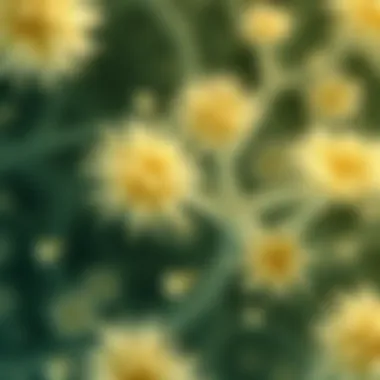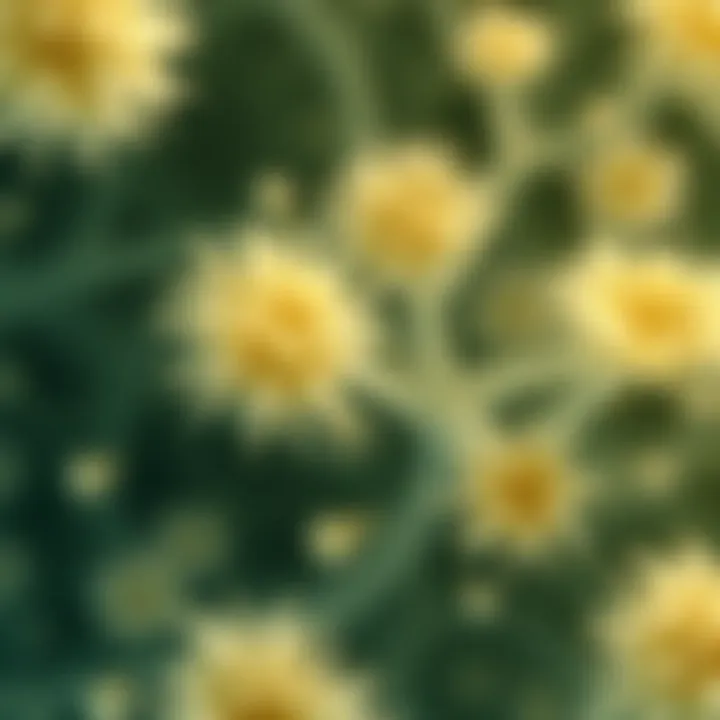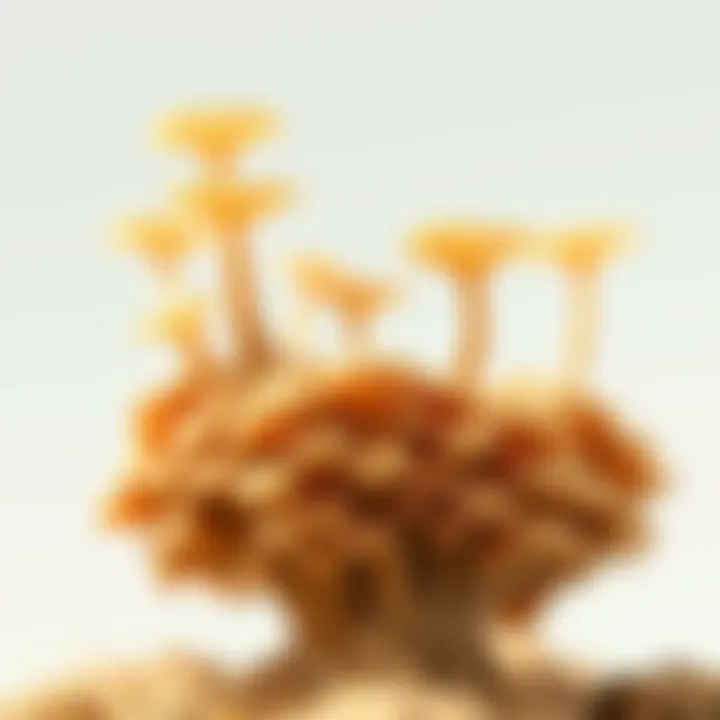Mycelium Fungi: The Hidden Web of Life's Impact


Intro
Mycelium fungi, often overlooked, are a vital and intricate component of our ecosystems. This remarkable network, lying just beneath our feet, plays a crucial role in sustaining life, facilitating nutrient cycling, and fostering connections among diverse biological entities. Imagine it as a bustling underground city, with threads stretching across vast distances, linking organisms in ways we’re still just beginning to grasp. Understanding this hidden web offers profound implications not only for ecology but also for technology, sustainability, and even medicine.
This article aims to uncover the myriad facets of mycelium fungi, presenting insights into their biological structure and ecological significance. From their pivotal role in nutrient cycling to their potential as sustainable materials, the relationship between mycelium and various fields is spellbinding. Ongoing research is revealing how this organism might provide innovative solutions to some of our modern challenges, making it the focus of scientific inquiry and environmental advocacy alike.
Among the many topics we’ll discuss, the latest technological applications of mycelium stand to amaze. Cutting-edge advancements in fields such as material science and environmental remediation hinge on understanding and harnessing the capabilities of these fungi. We’ll also touch on the gaps in current research, encouraging a deeper exploration into the potential of mycelium in various sectors. Whether you're an ecologist, a tech enthusiast, or simply curious about the natural world, the story of mycelium fungi is one that reveals the interconnectedness of all life.
Let’s step into the fascinating world of mycelium, where science meets innovation and ecological wisdom intertwines with technology.
Prelude to Mycelium Fungi
The realm of mycelium fungi is both vast and intricate, serving as a cornerstone for understanding the ecological web that supports life on Earth. As the main body of fungi, mycelium represents a network of hyphae, crucial for various biological functions. The significance of exploring mycelium fungi lies in its ability to bridge numerous domains, including environmental science, biotechnology, and sustainability. By digging deeper into this topic, we not only unravel the complexity of ecosystems but also uncover potential benefits for future innovation and environmental restoration.
Defining Mycelium
Mycelium is more than simply a mass of fungal threads; it is the lifeblood of forest ecosystems. Essentially, it acts as the vegetative part of fungi, consisting of a dense network of hyphae that grow below the soil surface. These threads weave through the soil like a fine tapestry, connecting trees and plants, facilitating nutrient sharing and communication. Imagine walking through a forest where the trees are engaged in a silent conversation, sharing resources and warnings through this unseen web. In essence, mycelium is that medium, the connector, and a fundamental player in biological processes.
The various types of mycelium can vary from the white, fluffy mycelium often spotted in the wild to the dark, dense networks that thrive in more nutrient-rich environments. Functionally, this structure allows fungi to absorb moisture and nutrients from the substrate, playing a critical role in decomposition and nutrient cycling.
The Life Cycle of Fungi
Understanding the life cycle of fungi, particularly mycelium, provides insight into their role in ecosystems. The life cycle is generally divided into several key stages: spore production, germination, vegetative growth, and reproduction.
- Spore Production: Fungi begin life as spores, which are tiny reproductive units that can travel through air, water, or by attaching to animals.
- Germination: When conditions are right, a spore germinates into hyphae, the beginning of mycelium. Here the fungal threads start to develop and expand.
- Vegetative Growth: The mycelium continues to grow, absorbing nutrients and water and forming a robust network that spreads throughout the substrate. This stage is crucial for its interactions with plants and other microorganisms, establishing symbiotic relationships.
- Reproduction: When environmental conditions become favorable, the mycelium can produce fruiting bodies—think of mushrooms emerging from the ground. These structures generate spores, and the cycle begins anew.
Through this cyclical process, mycelium fungi contribute significantly to the overall health of ecosystems, setting the stage for nutrient cycling and plant growth, creating a sustainable environment.
"In every step of the life cycle, mycelium plays a pivotal role, ensuring the delicate balance of ecosystems is maintained, and, thus, life continues to thrive."
Mycelium Structure and Function
Understanding the structure and function of mycelium is essential in grasping its ecological and biological significance. Mycelium fundamentally acts as the root system of fungi, creating an extensive network that interconnects individual organisms in an ecosystem. This underground web facilitates nutrient sharing, communication between plants, and contributes to soil health, making mycelium a vital player in the survival and efficiency of the flora around it. The two primary aspects to consider are hyphal networks and nutrient absorption mechanisms.
Hyphal Networks
Types of Hyphae
Hyphae are thread-like structures that compose mycelium, and they come in various types, each serving a distinct purpose in the life of the fungus. The most common forms are septate and aseptate hyphae.
- Septate Hyphae: Characterized by being divided into compartments by cross-walls or septa. This type can effectively compartmentalize damage or infection, allowing the fungus to continue its growth.
- Aseptate Hyphae: With no septa, this type allows for rapid growth and can transport nutrients over long distances quickly.
The benefit of having these types of hyphae lies in their adaptability. Septate hyphae can safeguard against adverse conditions, while aseptate hyphae excel in their efficiency. As a characteristic of all fungi, the variety in hyphal types enables mycelium to thrive in diverse environments.
Growth Patterns
The growth patterns of mycelium demonstrate its ability to adapt and thrive. Mycelium expands through a process called apical growth, where hyphal tips reach outwards.
- Radial Growth: This is where the mycelium grows evenly in all directions, forming a circular shape, which maximizes its reach to absorb nutrients.
- Directional Growth: Sometimes, mycelium will grow toward a nutrient source, exhibiting a targeted approach that ensures optimal nutrient uptake.
These growth patterns allow fungi to adapt quickly to their environment, providing a competitive advantage for survival. The downside of this rapid growth can lead to resource depletion, making it crucial for mycelium to balance expansion with sustainability.
Substrate Interactions
Mycelium interacts closely with its substrate, affecting its growth and nutrient absorption.
- Mycorrhizal Interactions: Many fungi form symbiotic relationships with plant roots, increasing nutrient uptake while benefiting from the plant's photosynthesis by-products.
- Saprophytic Interactions: Other fungi break down dead organic matter, recycling nutrients back into the ecosystem.
These interactions showcase the versatility of mycelium in both parasitic and mutualistic roles. While beneficial to the environment and plants, it is important to note that pathogenic hyphae can lead to disease in plants, which can cause economic losses in agriculture.


Nutrient Absorption Mechanisms
Digestion Processes
Fungi can’t consume food like animals or humans. Instead, they release enzymes that break down complex organic materials externally into simpler substances that can be absorbed.
- Extracellular Digestion: Mycelium secretes enzymes that decompose substances like lignin and cellulose, transforming them into forms easily absorbable by the hyphae. This process allows mycelium to exploit a variety of resources.
- Nutrient Efficiency: This method of digestion is efficient and conserves energy, making fungi exceptionally suited for nutrient-poor environments.
While this process may seem advantageous, it can also lead to toxicity in areas where decomposition is not needed, highlighting the need for environmental balance.
Enzyme Production
The enzymes produced by fungi are central to their survival and adaptability. Different fungi produce various enzymes like cellulases, ligninases, and proteases depending on their ecological niche.
- Specialization: Some fungi specialize in breaking down specific types of materials, allowing them to thrive in particular environments. For example, certain wood-decaying fungi excel in cellulose breakdown.
- Environmental Response: In response to changing environmental conditions, fungi can alter their enzyme production, optimizing their nutrient acquisition strategy.
This adaptability in enzyme production allows fungi to contribute significantly to nutrient cycling in ecosystems. However, excessive enzyme activity can lead to over-decomposition, resulting in nutrient vacancies in the soil.
In summary, the structure and functions of mycelium—from its intricate hyphal networks to its efficient nutrient absorption mechanisms—highlight the vital role fungi play in sustaining ecosystems. Understanding these aspects paves the way for appreciating their broader ecological impact and the opportunities they present in technology and sustainability.
Ecological Importance of Mycelium
The role of mycelium in ecosystems often goes unnoticed, yet it’s like the invisible backbone holding the forest floor together. Understanding the ecological importance of mycelium sheds light on its vital contributions, especially in areas like nutrient cycling and its symbiotic relationships with a variety of organisms.
Mycelium acts as the digestive system of the earth. Fungi break down complex organic materials, allowing nutrients to be recycled back into the soil, which is crucial for sustaining plant life and promoting healthy ecosystems. This decomposition process not only aids in nutrient restoration but also supports a diverse array of life forms, ensuring that ecosystems remain resilient and robust in the face of environmental changes.
Moreover, mycelium's intricate networks create a kind of biological internet, facilitating communication and resource sharing among plants. It may seem subtle, but these connections can have profound implications for biodiversity and ecological stability. It’s a classic case of
"what goes around comes around,” where the interlinked web promotes a thriving habitat for all living beings.
"Fungi have a critical role in the nutrient cycles of terrestrial ecosystems, influencing plant health and soil fertility."
Decomposition and Nutrient Cycling
Mycelium plays a pivotal role in decomposition. When organic matter like fallen leaves, dead trees, or animal remains begin to break down, mycelial networks jump into action. They produce enzymes that decompose complex substances like cellulose and lignin found in plant material. These enzymes are crafted with precision, enabling the fungi to digest materials other organisms can’t handle. Without this decomposing action, organic matter would accumulate, leading to scarce nutrients in the soil, which could choke biodiversity.
This process involves several steps:
- Enzyme Production: Fungi secrete enzymes that break down difficult compounds into simpler substances.
- Nutrient Release: Through decomposition, essential nutrients like nitrogen, phosphorus, and potassium are released back into the soil.
- Nutrient Cycling: Plants absorb these nutrients, allowing them to thrive, which in turn supports herbivores and subsequently the entire food chain.
Thus, the nutrient cycling facilitated by mycelia not only sustains plant life but also underpins entire ecosystems, creating a balance essential for life.
Symbiotic Relationships in Nature
Symbiosis, where different organisms exist in mutually beneficial relationships, is a hallmark of the biological realm. Mycorrhizal associations—the relationships between mycelium and plant roots—highlight how fungi enhance plant health while reaping benefits in return. This form of relationship plays a significant part in nutrient uptake for plants.
Mycorrhizal Associations with Plants
In mycorrhizal partnerships, fungi attach themselves to the root systems of plants, extending their hyphal networks into the soil. This adaptation expands the plant's reach for vital nutrients and water. In return, plants supply the fungi with carbohydrates generated through photosynthesis. As a result, plants flourish, especially in nutrient-poor soils where mycorrhizal fungi can make all the difference. Key characteristics of mycorrhizal associations include:
- Enhanced Nutrient Uptake: The fungal hyphae provide plants with greater access to phosphorous and other essential nutrients.
- Soil Structure Improvement: The presence of these fungi will improve soil aggregation, enhancing water retention.
- Increased Disease Resistance: Mycelium can help shield plants from pathogens by competition and chemical means.
However, reliance on mycorrhizal partners can have disadvantages. For instance, not all plants form such relationships, which may lead to varying growth success in ecosystems, and some fungal species may compete with beneficial fungi, disrupting these essential networks.
Impact on Biodiversity
The interconnection created by mycelium is not just limited to plants; it permeates through animal life and other organisms too. The diversity of fungi, especially mycorrhizal species, contributes significantly to biodiversity. By helping plants thrive, these fungi support various organisms depending on plants for food and habitat. Key characteristics such as:
- Species Diversity: A wide range of fungi serves a broad spectrum of plants, promoting a complex web of life.
- Ecosystem Stability: Healthy mycorrhizal networks contribute to ecosystem resilience during climatic shifts.
The downside can be that ecosystems overly reliant on specific forms of fungi can be vulnerable to changes if those fungi are adversely affected. Nevertheless, the positive contributions of mycelium in fostering biodiversity make it a valuable component of ecological health.
In summary, the ecological importance of mycelium is irrefutable. Its central role in decomposition, nutrient cycling, symbiotic relationships, and species diversity underlines mycelium's status as a cornerstone of life on Earth. Understanding this hidden web can inform better environmental management practices, ensuring we harness the powers of mycelia for a sustainable future.


Mycelium in Technology and Innovation
Mycelium fungi have emerged as a game changer in various sectors, thanks to their intrinsic properties and remarkable capabilities. The conversation around mycelium's role in technology and innovation is crucial today, as it not only highlights potential solutions to ongoing environmental challenges but also showcases a broader understanding of how living organisms can be integrated into human-centered designs. Mycelium’s versatility stands out particularly in the realms of materials science and biotechnology, making it an essential focus of contemporary research and development.
Biodegradable Materials
Packaging Solutions
In a world inundated with plastic waste, mycelium-based packaging solutions offer a refreshing alternative. These eco-friendly materials are created by cultivating mycelium in a mold filled with organic waste, which subsequently forms a sturdy, biodegradable product. This type of packaging reduces reliance on fossil fuels and, perhaps more importantly, offers a way to keep waste out of landfills.
A key characteristic of mycelium packaging is its natural insulation properties, which makes it suitable for shipping temperature-sensitive items. Such solutions not only fulfill an important ecological role but offer a practical edge by being lightweight and easy to manufacture. One notable feature of these products is their ability to decompose in a matter of weeks in the right conditions, a significant leap from conventional plastic packaging that lingers for hundreds of years.
However, there are some challenges. While mycelium packaging stands out in sustainability, scalability remains a question. The complexity of production can pose hurdles for large-scale applications. Once these hurdles are cleared, mycelium’s packaging could become a preferred choice across industries aiming to meet their sustainability goals.
Construction Materials
Mycelium is also making waves in the construction industry, where it is used to produce building blocks that boast impressive strength and insulation properties. These mycelium-infused materials can replace more traditional options, often found in concrete and insulation foam that contribute to significant environmental degradation.
A major benefit of mycelium construction materials is their overall low carbon footprint. Combined with agricultural waste, the mycelium can create lightweight yet strong components that meet necessary building codes. The unique aspect here is their natural ability to insulate, making homes made from such materials energy-efficient and environmentally friendly.
On the flip side, the primary drawback mostly revolves around the regulatory challenges in the construction sector. Building codes and regulations may lag behind innovations, creating a bottleneck for widespread adoption. Nevertheless, continued research and advocacy may pave the way for wider acceptance, pushing mycelium construction materials into the spotlight.
Mycelium in Biotechnology
Health and Medicine
In the field of health and medicine, mycelium is being integrated into a range of applications from drug delivery systems to tissue engineering. This versatility lies in its compatibility with human tissues, making it an increasingly attractive candidate for developing medical devices and biodegradable implants.
The standout trait of using mycelium in health is its natural composition, as it tends not to provoke immune responses, making it safe for human use. Innovations stem from the potential of mycelium to serve as scaffolding in regenerative medicine or even as a medium for microbe-based therapies, which can target specific ailments like infections or inflammation.
However, challenges do exist. The regulatory aspect in medical applications often tests the pace of adoption, as everything from testing to certification can be resource-intensive. Despite these hurdles, the promise of mycelium in healthcare remains undeterred.
Bioengineering Potential
The bioengineering potential of mycelium stretches far beyond its traditional uses, coaxing researchers to explore its capabilities in environmental remediation and waste management. With its natural ability to break down complex organic materials, mycelium could offer unprecedented solutions for treating contaminated environments.
Its key characteristic here is its adaptability to various substrates, allowing it to thrive in diverse conditions while simultaneously working to remediate soil health. The barrier it faces, however, is primarily one of perception; many remain skeptical of its efficacy and versatility in large-scale applications. Engaging in rigorous research and practical demonstrations could help change that perception over time.
Finale
In summation, the integration of mycelium into technology and innovation opens up avenues previously unthinkable. As these materials gain traction across packaging and construction, as well as their potential in the health sector, mycelium can offer solutions to pressing environmental and social issues. Continued exploration and development could ensure that mycelium's future is bright, making way for a sustainable and innovative tomorrow.
Challenges in Mycelium Research
The complexity of mycelium fungi presents a variety of challenges that researchers and enthusiasts must navigate. One of the foremost concerns in this field is understanding the broad spectrum of species diversity. There are thousands, if not millions, of fungal species out there, each playing a unique role in its ecosystem. This intricate diversity means that studying mycelium is never a straightforward task. It’s like trying to learn a foreign language where every dialect holds its own secrets and nuances.
Understanding Species Diversity
When we talk about species diversity in fungi, we touch upon a vast network of evolutionary adaptations that allow each species to thrive in specific conditions. The challenge lies in classifying these species accurately. Traditional methods rely heavily on morphological characteristics, but many fungi share similar physical traits while differing genetically. This leads to the misidentification of species, which can skew research results and limit our understanding of their ecological roles. An example of this can be seen with certain types of mycorrhizal fungi: while their hyphal structures may look the same under a microscope, their behavior and beneficial impacts on plants can differ greatly.
Moreover, many fungi remain undiscovered or poorly understood, often buried in obscure ecosystems. As researchers hurry to document these species, there’s a risk of overlooking critical interactions that could provide insights into resilience in changing climates.
Cultivation and Scaling Issues
The cultivation of mycelium presents a second set of layers layered in difficulty, primarily regarding optimal growth conditions and commercial viability. Might not seem too tricky at first glance, but not all fungi are created equal when it comes to growth preferences.
Optimal Growth Conditions
Optimal growth conditions for mycelium fungi encompass several factors, such as temperature, humidity, and the type of substrate used. For instance, certain species flourish in warm, humid environments, while others prefer cooler climates. Understanding these specific needs is vital when looking to cultivate mycelium for practical applications. A key characteristic of optimal growth conditions is that they must be carefully balanced. Too much moisture can lead to contamination, while too little can stunt growth. Thus, growers must constantly tweak and monitor their setups—a task that can be both rewarding and demanding. The distinct feature of optimal conditions often requires a keen understanding of each fungal species’ lifecycle which is paramount for production goals.
Commercial Viability


Commercial viability ties in directly with the growth conditions mentioned earlier. For a mycelium-based product to make it to market successfully, it must not only be growable under optimal conditions but also cost-effective. This poses another hurdle for researchers and entrepreneurs alike. The unique feature of commercial viability lies in scalability; what works on a laboratory scale may not yield the same results when multiplied. Therefore, assessing whether a mycelial product can compete with traditional materials in terms of price and availability becomes crucial. On the flip side, with growing awareness of sustainability, the market for mycelium products is slowly gaining traction, allowing researchers to discover innovative production methods that could reduce costs in the long run.
In summary, as the study of mycelium fungi progresses, addressing these challenges becomes ever more critical. Whether it’s grappling with species diversity or navigating the complexities of cultivation and commercial viability, every step taken sharpens our understanding of these fascinating organisms.
"The study of mycelium is a journey into the unknown, where each discovery unravels another thread of the vast web of life that fungi weave."
Delving into these aspects reinforces the need for continued research and collaboration. Given the potential mycelium holds for innovation, overcoming these hurdles may unlock new avenues that benefit ecosystems and economies alike. For a more in-depth understanding of the subject, you can refer to resources such as Encyclopedia Britannica, Wikipedia, and relevant journals on mycology.
Future Directions for Mycelium Studies
The future of mycelium studies lies in a realm rich with promise and potential. As awareness grows about the incredible influence mycelium fungi can wield in addressing ecological challenges, the need for interdisciplinary research is becoming more critical. Various fields such as biology, environmental science, and technology intersect to unlock new avenues in understanding how mycelium can revolutionize the way we perceive sustainability and the natural world.
Interdisciplinary Research Opportunities
Mycelium fungi have been a significant point of intersection for various academic and practical disciplines. By bringing together experts from diverse backgrounds—such as mycologists, environmentalists, and engineers—we can develop holistic strategies that harness the power of mycelium. Collaborative projects can lead to innovative applications, from creating sustainable materials to bioremediation techniques where mycelium helps detoxify polluted environments. For example:
- Biology: Investigating fungal genetics to enhance cultivation methods.
- Agriculture: Applying mycorrhizal fungi to improve crop yields sustainably.
- Chemistry: Developing organic compounds to increase nutrient absorption efficiency.
The cross-pollination of ideas from these varied fields can spur groundbreaking discoveries that may rewrite how we think about the relationship between nature, industry, and community.
Sustainable Practices and Environmental Impact
As the discussion on climate change intensifies, mycelium presents sustainable practices that can significantly mitigate environmental damage. Two primary aspects are particularly impactful: carbon sequestration and restoration ecology.
Carbon Sequestration
Carbon sequestration through mycelium fungi acts as a natural method to trap carbon dioxide from the atmosphere, mitigating climate change. The unique ability of mycelium to break down organic matter allows it to store carbon within its structure, creating long-term carbon sinks. This process not only benefits the environment by reducing greenhouse gases but also enhances soil health by enriching it with nutrients. A key characteristic of this approach is its scalability; from small urban gardens to extensive forest restoration projects, mycelium can play a role.
A notable feature of carbon sequestration involves assessing the soil amendments enriched with mycelium that can effectively capture CO2. Given the urgency of reducing atmospheric carbon levels, this method stands out as a promising and increasingly popular practice in ecological studies.
Restoration Ecology
Restoration ecology, which focuses on rehabilitating damaged ecosystems, deeply ties into mycelium's role in nature. This practice uses mycelium's ability to rebuild soil structure and improve nutrient cycling, fostering healthier ecosystems. It acts as a natural bridge, supporting plant regrowth and stabilizing soil, which is crucial in areas affected by erosion or urban development.
The unique feature here is the mycelium's potential to establish a productive network within ecosystems. This can be a game-changer, providing plants with the necessary support to flourish in challenging environments. However, challenges arise in understanding the specific conditions under which mycelium thrives, requiring further research to optimize its effectiveness in various restoration contexts.
"Together, these pathways of exploration reflect the significant role mycelium fungi can play in future research towards a sustainable planet."
As we ramp up efforts to study these promising avenues, the implications of mycelium’s potential reach far beyond traditional ecological limits, beckoning a new era in sustainable practices that critically aligns with environmental needs.
Ending: The Significance of Mycelium Fungi
The significance of mycelium fungi permeates various facets of both ecological balance and human innovation. As we have traversed the textured landscape of mycelium's biology, its ecological roles and potential breakthroughs in technology, it becomes clear that these fungi are not mere background players in the natural world; rather, they are fundamental actors in a much larger drama of life on Earth.
Mycelium serves as Nature's recycler. The hyphal networks break down organic materials, returning vital nutrients back to the ecosystem, thus sustaining plant life and contributing to soil health. This nutrient cycling underscores its pivotal role in forest ecosystems, where the rich interconnectivity of plant roots and fungal hyphae not only maximizes nutrient uptake but also enhances plant resilience.
In the technological realm, mycelium's potential as a sustainable resource is expansive. From biodegradable packaging to synthetic materials, its ability to thrive in diverse substrates opens avenues for innovation that align with environmental sustainability goals. Moreover, utilization of mycelium in biotechnology has implications for health and agriculture, promising avenues like natural pest control and medicinal applications derived from fungi.
As we witness the burgeoning focus on sustainability, mycelium fungi emerge as beacons of hope. They provide practical solutions in dealing with pollution, deforestation, and resource depletion. As an integral component in the quest for renewable resources, understanding mycelium could unlock pathways to restore ecosystems and combat climate change.
"In the tapestry of life, mycelium represents the threads connecting all organisms, weaving a web of interdependence that underscores the fragility and resilience of our ecosystem."
In essence, the study of mycelium fungi illuminates the interconnectedness of life forms and the pressing necessity to explore their extensive applications. This conclusion acts as a reminder that as scientific investigations advance, becoming more refined, the hidden potential of mycelium remains an ongoing narrative worthy of our attention and respect.
Recapitulating Key Insights
As we summarize the key points discussed, it’s evident that mycelium fungi are a linchpin in both ecological and technological contexts. The versatile roles they play in nutrient cycling, symbiotic relationships, and their promise in pioneering new technologies are not merely impressive; they are imperative. Key takeaways include:
- Nutrient Cycling: Mycelium aids in the breakdown of organic matter, enriching soil and supporting plant life.
- Symbiosis: Their forming of partnerships, especially mycorrhizal associations with plants, enhances biodiversity and ecosystem resilience.
- Sustainability: Mycelium is being explored for its potential to replace plastic and create biodegradable materials.
- Health and Medicine: The medicinal properties of various fungi open new doors for treatment and endemic solutions to health issues.
Mycelium's Role in Future Research
Looking forward, mycelium fungi hold considerable potential for deeper exploration around various themes. A few focal points for future research may include:
- Genetic Insights: Understanding the genetic diversity of mycelium can unravel its adaptability and resilience in various environments.
- Industrial Applications: Continued exploration of mycelium in industrial processes may change the landscape of manufacturing and waste management.
- Ecological Restoration: Investigating how mycelium can assist in restoring damaged ecosystems presents avenues for practical conservation efforts.
- Climate Change Mitigation: Studies focusing on carbon sequestration capabilities of mycelium could significantly contribute towards global efforts to reduce atmospheric carbon.
For additional exploration, you might find resources from sites such as Wikipedia, Encyclopedia Britannica, and Reddit discussion forums especially enlightening.







